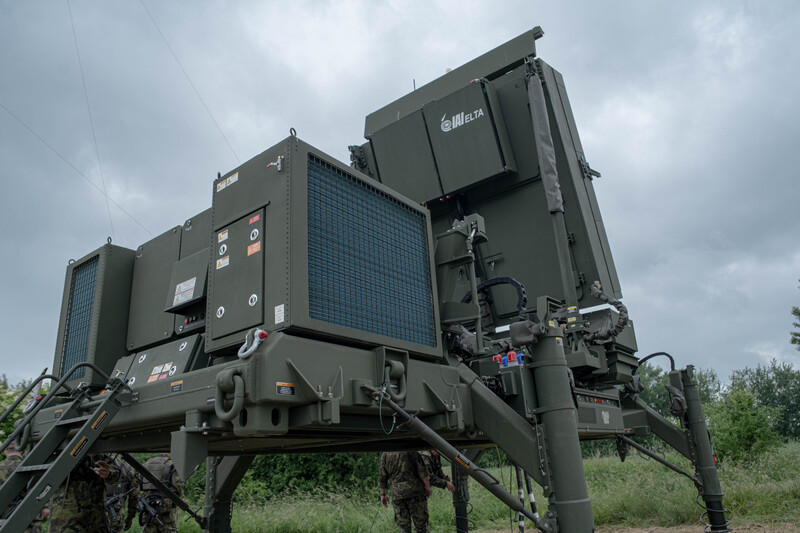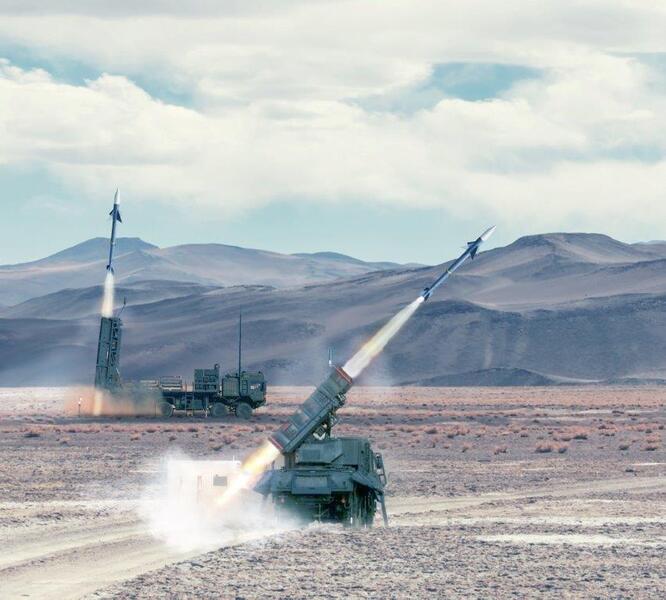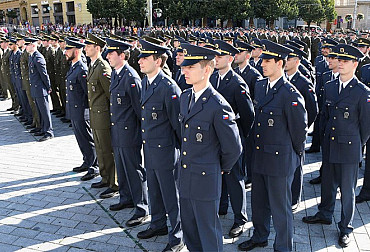Summer military tests of EL/M-2084 radar were successful
Recently, military trials were held at Libavá and Přerov Airport to test the characteristics of the new Israeli-made EL/M-2084 mobile 3D radar, which was the first of a set of purchased equipment delivered to the Stará Ves nad Ondřejnicí radio engineering unit, which is part of the 262nd Radio Engineering Battalion of the 26th Command, Control and Reconnaissance Regiment.
 Picture: Military tests of the EL/M-2084 radar are going well | Capt. Jiřina Polcrová
Picture: Military tests of the EL/M-2084 radar are going well | Capt. Jiřina Polcrová
To Libavá and Přerov airfield for tests
The EL/M-2084 radar as a new mobile radar from the Israeli manufacturer Elta Systems is undergoing a series of tests and one of them directed this Multi Mission Radar to the Strážisko area, which is part of the Libavá military base. The mobile radar has thus completed one of its first trips from Stará Ves to the Moravian airfield and subsequently to the Přerov airport. As confirmed by a member of the military tests, Lt. "I got acquainted with the EL/M-2084 radar at the course in Israel, which I attended together with other specialists of the radio engineering troops at the beginning of this year. I am now in my third month of participating in the military trials of this device, observing the various procedures that are carried out on the radar. These include, for example, verifying the device's functionality as an artillery radar with the ability to detect mortar or artillery shells, or verifying its ability to guide anti-aircraft missiles over distances of tens of kilometres. With these capabilities, the EL/M-2084 can fully replace previously used Russian radars," said an engineering officer with the 262nd Radio Engineering Battalion.
Guarding a secure area
One of the main tasks during the military trials at the Libavá military base was the actual guarding of the EL/M-2084 mobile radar. This task was taken care of by the protection platoon of the 262nd Radio Engineering Battalion in the middle of June, when the subordinate radio engineering companies and persons from the battalion staff participated in the allocation of individual members. For Lt. Bc. "As the deputy commander of the company in Sokolnice, I have been through many exercises, participated in many jobs, and so I was able to use my knowledge and practical skills in this task, which was a bit of a challenge for me. As a Protection Platoon Leader, I was tasked with guarding the outer perimeter of the EL/M-2084 MADR radar site as well as conducting protection of the secure area inside the perimeter of the site."
 Picture: Radar EL/M-2084 | Capt. Jiřina Polcrová
Picture: Radar EL/M-2084 | Capt. Jiřina Polcrová
No entry without clearance
"Prior to the actual commencement, the organisation of the activities of my platoon, their two protection shifts and individual members was established. As the commander, I was responsible for ensuring that the setup of the access regime to the area and the guarding of material and documentation was carried out in accordance with all provisions relating to the protection of classified information and physical security in the Ministry of Defence. No one was allowed to enter the area without a clearance and a special card," said 1st Lieutenant Matula.
Logistical support first and foremost
It would not have been possible without the facilities – this is how one sentence can summarise the fact that played a key role in securing the military tests and manoeuvre of the EL/M-2084 radar. The activities of the 262nd Radio Engineering Battalion and logistic support, which was provided by the soldiers of the 263rd Support Battalion of the 26th Command, Control and Reconnaissance Regiment, are also highlighted by the representative of the protection platoon, Master Sergeant Martin Grund: "The unit's task was to provide all-day meals for the members of the protection platoon and the radar operator, to refuel our vehicles, power centres and the radar itself, including its Tatra 815-7 vehicle. It was also necessary to ensure the construction of the facilities as such. I appreciate the professional approach of the members of the platoon, as the facilities were quickly and correctly built. The professionalism of the members of the protection platoon was demonstrated not only in the construction of the EL/M-2084 site (setting up tents, marking out perimeters to prevent unauthorised persons from entering), but above all in the implementation of its protection."
Interaction with other units
"I think our battalion did a great job. In an event like this, cooperation with other units is always appreciated. In this case, it was members and employees of the Force Development Section of the Ministry of Defence, the 13th Artillery Regiment Jince, the 533rd Unmanned Systems Battalion Prostějov and the 22nd Helicopter Air Base. The joint effort in successful testing of new radar devices will lead to even greater interdependence and cooperation between our units, which is an important aspect not only from the point of view of the 262nd Radio Engineering Battalion in maintaining a constant overview of the air situation, but a common path in the fight against a common enemy," said the commander of the 262nd Radio Engineering Battalion, Lt.Col. Josef Ordelt.
The question of the number of SHORAD complexes
According to the above-mentioned official communication from the Ministry of Defence, everything is going smoothly and according to plan. However, it is still a question whether the number of batteries ordered so far (4) is sufficient for our needs. Each battery of the SPYDER system will provide protection of an area of 55 x 55 km, which is less than 16% of the area of the Czech Republic in the case of four batteries. The main task is to secure objects important for national defence (ODOS), whether military or non-military by government decision. The Concept of build-up of the Czech Army 2030 speaks of a "maximum of three ODOS". There are only two nuclear power plants in the Czech Republic. In addition to the capital, there are a long list of other major targets to defend, and especially with the possibility of a high intensity attack, as we are seeing in Ukraine, the question (and automatic answer) is whether four batteries are sufficient. If in peacetime, for example against a terrorist threat, a single anti-aircraft missile squad may be sufficient (more for maintaining capabilities within the armed forces), for deployment in a symmetrical high-intensity conflict it is a rather negligible force.
 Picture: SPYDER anti-aircraft missile set | Ministry of Defence of the Czech Republic
Picture: SPYDER anti-aircraft missile set | Ministry of Defence of the Czech Republic
The feeling that the Czech Republic stands far away from the hotbeds of potential conflicts should leave us completely. We can look to Poland, for example, which is modernising its armed forces at an accelerating pace. In the area of air defence, it will rely primarily, in addition to various VSHORAD systems (for example, the Narew system developed in cooperation between MBDA and PGZ-Narew) and the old Soviet S-125 and S-200 systems, on eight batteries of the US Patriot Medium Range Air Defence System (64 launchers) and two batteries (six launchers) of the British CAMM system.
Today, the German Bundeswehr (Luftwaffe) has one anti-aircraft missile squadron (Flugabwehrraketengeschwader 1 'Schleswig-Holstein'), to which all surface-to-air missile units of the German Air Force are subordinated, with the exception of Flugabwehrraketengruppe 61 (integrated into the Dutch air defence). In addition to the Air Defence Centre, the squadron consists of three groups (Nos 21, 24 and 26) at Sanitz, Bad Sülze and Husum. The units are deployed to protect areas, objects or groups of objects as well as mobile operations. Their mission is to provide extensive and sustained airspace protection. Since the retirement of the HAWK and Roland weapon systems at the end of 2005, ground-based air defence has mainly been carried out using the Patriot system. In 2013, Germany had twelve batteries. Then, in response to Russian aggression against Ukraine and the need to secure NATO's eastern flank, Germany recently sent an undetermined number of these systems to Slovakia.
The appropriate number of air defence assets and their parameters are alchemy. The correctness and effectiveness of the mix will always be confirmed only by the need for live deployment. In view of the location and size of the Czech Republic's territory, the question of long- and medium-range systems can be addressed in cooperation with neighbouring allied states and by seeking all-round appropriate and economic solutions. However, self-sufficiency is important in the area of SHORAD and VSHORAD, including the ability to destroy rocket, artillery and mortar missiles in motion while protecting manoeuvring troops. The means are already selected in this area; thus, all that is needed is to strengthen capabilities – for obvious and unquestionable air defence capabilities are one of the essential elements of deterring a potential adversary.





















